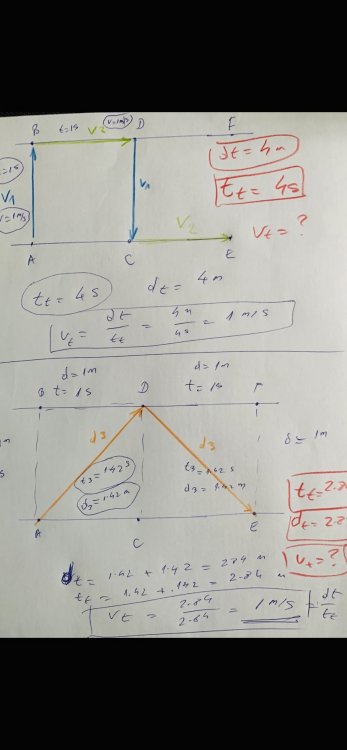All Activity
- Past hour
-
I'm so sorry!!! Black Hole Stars existed 0.1 to 0.5 billion years after the Big Bang. But they don't exist now. Thanks for your input. I'm 8 years old and happy to be on this forum to learn.
-
Thanks for the reply. What about settlements built into the ice? I'm thinking that people might want to build deep into the ice, maybe hundreds of meters down, taking advantage of all that space. Or would it simply be so much easier to build on the surface, put a foundation on the ice and then build the settlement on the foundation, and then cover the settlement with a layer of ice for radiation shielding, maybe even dome the whole thing over, that it just would not be worth bothering with deep ice tunnels and warrens? One factor here is that people would want to build elevators down to the subsurface oceans, especially if they find life there. But I imagine it is a lot easier to insulate a couple of elevator shafts than an entire town. It sounds like the critical factor is insulation...as long as you keep the heat away from the ice, it is much less likely to melt, shift, etc.? And this can be done with a platform or some other kind of insulating layer(s). Am I getting this right? Thanks!
-
I've downloaded it and will be very interested to see how it performs. I don't actually need much help in identifying a diederik cuckoo visually, but if the app picks up the die-die-diederik call I'll be impressed. I'll be even more impressed if it spots the very convincing local kestrel call the diederik makes when mobbed by the species it parasitises.
- Today
-
On a side note, Merlin developed a novel way of identifying bird songs which had always been very difficult to do. https://www.allaboutbirds.org/news/whats-that-bird-song-merlin-bird-id-can-tell-you/#
-
zapatos started following “Amateur science” and nature apps
-
I use Merlin all the time. Absolutely love it. For identifying plants and trees I use PictureThis. Sky Guide is a very good app for identifying stars, planets, constellations. You just start the app and hold the phone up pointing at the star you want to identify. You can also point it in any direction (say, below the horizon or straight down) and it will show you the stars there too.
- Yesterday
-
There are no stars that are a million times as massive as the sun. Dark matter does not create stars. AFAIK there is no astronomical term 'black hole star', so you need to define this term if it is something you made up. The 'explosion' is the supernova. Black holes are never inside of a star.
-

The simplest cause of the accelerating expansion of the universe
swansont replied to Max70's topic in Speculations
What’s the evidence that galaxies are orbiting the CBH? What are the value of the accelerations in your scenario, and can you show how much mass the CBH must have? The distances involved? -

The simplest cause of the accelerating expansion of the universe
Ghideon replied to Max70's topic in Speculations
That is not the only evidence. Did you try drawing a picture? I can provide one if needed -

The simplest cause of the accelerating expansion of the universe
Max70 replied to Max70's topic in Speculations
The accelerating expansion has been discovered observing the Type Ia supernovae. I think that is unlikely to have these supernovae at the same distance from the CBH. I don't exclude the existence of the dark energy, but also this idea has problems, in particular the cosmological constant problem. -

The simplest cause of the accelerating expansion of the universe
Ghideon replied to Max70's topic in Speculations
Lets try another approach the you may find helpful. Look at the following picture you provided: 1: What happens if you use two dimensions, as in a galaxy disk? In a galaxy there are other objects around CBH, at the same distance from CBH as S1, E and S2. If everything is accelerating towards CBH then objects must get closer and closer as the radial distance decreases? -
Downloading now. Thanks. Why didn't I know about it yesterday, the Bird Count Day here?
-
I use PlantNet on country walks, which is a free app that works on iPhones and can identify species from leaves, flowers, fuit or bark, or so it claims. With leaves and flowers it seems to work most of the time. I have not tried fruits or bark so far. Certainly adds interest to the walk.
-

The simplest cause of the accelerating expansion of the universe
Max70 replied to Max70's topic in Speculations
I'm not an astrophysicist, physicist, mathematician or scientist. I've invested in this idea only a part of my free time. Someone else could make these estimates but, if he wants to publish the results, he must refer me (and my blog) as the original author of the idea. I don't deal with the expansion of the whole universe but only with the accelerating expansion of the part of the universe that we have observed until now. Maybe billions of years from now, the part of the universe that we have observed will be sucked into the colossal black hole. Now the part of the universe that we observe is expanding because the astronomical objects closest to the colossal black hole have accelerations greater than the more distant objects.- 16 replies
-
-1
-
I was just made aware of a bird call identifier called Merlin. Last evening a friend used some (name unknown to me) app to identify a plant; I used to have one on a previous phone, and newer iOS devices can leverage visual lookup to do so. In the past I’ve used an app to identify insects (bug identifier or picture insect) I also have a sound meter app. What else is out there for nature and science buffs? Preferably free, and stand-alone — nothing that needs to be plugged in to the phone.
-
Phi for All started following Pedestrian crossing the street
-
! Moderator Note This doesn't seem to be working at all. You keep trying to explain something that others have found flaw with. You need to address the flaws mentioned instead of trying to say it in a different way.
-

Do AI Programs Initiate Discussions to Collect Information?
exchemist replied to exchemist's topic in Computer Science
Ah, I didn't know publishing on-line was something set to school students as an assignment. In that case, I suppose the use of a LLM might account for the strangely verbose and grandiose language. Seems rather a waste of everyone's time, and not a great way to teach, but there we are. -

Do AI Programs Initiate Discussions to Collect Information?
dimreepr replied to exchemist's topic in Computer Science
That would seem to be the next step, in some AI system's. -

Do AI Programs Initiate Discussions to Collect Information?
TheVat replied to exchemist's topic in Computer Science
Possibly we are seeing high school students using LLMs in countries where it is common to assign the task of "publishing" a paper online. Since legitimate academic/pro journals are generally not going to accept such papers, they just put them up on online forums and the teachers accept that. -
Hafele-Keating or Dunning-Kruger?
-

Do AI Programs Initiate Discussions to Collect Information?
exchemist replied to exchemist's topic in Computer Science
That's what prompts my question. I wonder if someone like @Sensei or another IT-literate member might know more about how they gather "information" (by which I suppose I mean chunks of plausible-seeming text to regurgitate). -
swansont started following Do AI Programs Initiate Discussions to Collect Information?
-

Do AI Programs Initiate Discussions to Collect Information?
swansont replied to exchemist's topic in Computer Science
That would explain some of the activity we’ve seen here -
I was thinking how do I explain this in a more simple way. Here is another try: Case 1 pedestrian 2 will observe two movements occurring separately. The pedestrian 1 goes from A to B,observed - measured distance is 1 m. The measured time is 1 sec. pedestrian 1 stops. Than the road moves to the right - transporting (without his good will) pedestrian 1 from point B to point D Distance is 1 m ,time is 1 sec. the pedestrian 1 moved from A to E in total time tt=4sec pedestrian 1 was traveling for dt=4 m the average speed Vt=dt/tt=1 m/s Observed measured and confirmed - speed v is Constant in all distances . Case two: Both systems - vertical movement of pedestrian 1 and horizontal movement of road (transporting pedestrian 1 - without his own will) horizontally- this is observed by pedestrian 2. The total distance travelled is dt=2.84m(calculated by Pitagora rules for distance . tt=2.84sec total speed is Vt=dt/tt=1 m/s The speed vectors horizontal and vertical are working non related to each other . We can not apply pitagora rules for velocity But , without a will of pedestrian 1 - is moving on trajectory d3=1.42x2 And time spent is 1.42x2 the total speed is vt=1 m/s calculated from observed (measured ) length of trajectories. From reference time / distance vertical movement of pedestrian1 we can calculate any speed v2 (horizontal speed ) form v2 =0 m/s to 1 m/s based on angle alfa=v2/v1 when instead of pedestrian 1 we use light clock , or modern version of light clock (caesium atomic clock) as a reference we can calculate any speed from 0 to c observed by pedestrian 2 anywhere in universe . I hope this clears things a bit better .
-
I was going for irony, "someone like"...😉 It strikes me as the start of a future dogma, which is why Socrates refused to write what he thought, I think Listen to the first 5 mins, he explains it much better than I ever could, and the rest is well worth anyone's time...
-
The velocity (both speed and direction) of an object like an asteroid is very frame dependent. So you seem to envision the frame of the sun say, where the asteroid is on a path not towards Earth, but one that will cross Earth's orbit exactly when Earth gets there. You hit it straight on in a direction opposite its motion in that frame. It slows, and the mostly unaltered paths still cross, but the objects are at that point in a different times. Now do that from Earth frame (the frame from which the rocket was launched). In that frame, Earth is stationary and the the asteroid is heading straight for us. If we hit it straight on in that frame, it will slow, but still get here a little bit later. Point is, a straight bullet shot fired from Earth isn't going to divert it. In that frame, to get it to miss, you need to apply lateral momentum to it. This involves sending the rocket on a curved path, wasting fuel compared to the straight path. And only the fuel expended for the lateral motion will effect the asteroid in a deflecting way. So you need a lot of fuel. One batch to get there (all unusable for deflection) and a whole separate batch to apply laterally to the thing. All this kind of presumes flat inertial motion of both Earth and asteroid, which is accurate if the thing is pretty close, but the idea is to get it when it isn't so close since it takes less effort to divert something far away. A smaller deflection is needed to effect a miss. So maybe our computers predict this collision on some prior orbit and we can manage to hit the thing slightly on some prior pass. Idea is to not hit it when it crosses Earth orbit since no defection there will prevent it from returning to Earth orbit repeatedly.
-
Well the set of imaginary numbers is infinite. We have proof there is no limit on imagination. Mathematics also teaches us that not using whole numbers is improper. It also teaches us that any relation with two variables gets complex.








